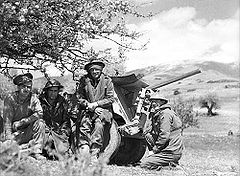| Battle of Vevi | |||||||
|---|---|---|---|---|---|---|---|
| Part of World War II | |||||||
 Members of the Australian 2/1st Anti-Tank Regiment resting, soon after their withdrawal from the Vevi area. | |||||||
| |||||||
| Belligerents | |||||||
|
|
| ||||||
| Commanders and leaders | |||||||
|
|
| ||||||
| Strength | |||||||
|
Eight infantry battalions Elements of one machine gun battalion and several artillery batteries |
One mechanised brigade (Waffen SS) One armoured brigade (German Army) | ||||||
| Casualties and losses | |||||||
|
British Empire 56 killed (28 Australians,[a] about 27 British,[b] 1–2 NZ [c]) 480 captured[3][4][5] Greece: 40 killed/wounded[d] 136 captured[d] |
37 killed 98 wounded 2 captured[10] | ||||||
The Battle of Vevi (or Veve, Greek: Μάχη της Bεύης), in Greece, also known as the Battle of the Klidi Pass, was part of the Greek campaign of World War II. It took place on 11–12 April 1941, north of the town of Amyntaion, close to the northwestern Greek border. Allied troops fought forces from Nazi Germany.
- ^ a b Commonwealth War Graves Commission site http://www.cwgc.org/, using "Geoff's search engine" tool found on http://www.hut-six.co.uk/cgi-bin/search39-47.php, accessed 16 September 2012
- ^ Commonwealth War Graves Commission site http://www.cwgc.org/
- ^ Australian War Memorial, Roll of Honour (A full list of Australian deaths by date can be obtained through the advanced search page)
- ^ Long (1953), p. 71
- ^ McClymont (1959), p. 210
- ^ a b c Το Τέλος Μιας Εποποιίας, ΔΙΣ, Αθηναι 1959, page 28
- ^ a b Το Τέλος Μιας Εποποιίας, ΔΙΣ, Αθηναι 1959, page 30
- ^ Cite error: The named reference
kosisland1was invoked but never defined (see the help page). - ^ Büchner (1961), p. 223
- ^ Golla (2007), p. 230
Cite error: There are <ref group=lower-alpha> tags or {{efn}} templates on this page, but the references will not show without a {{reflist|group=lower-alpha}} template or {{notelist}} template (see the help page).